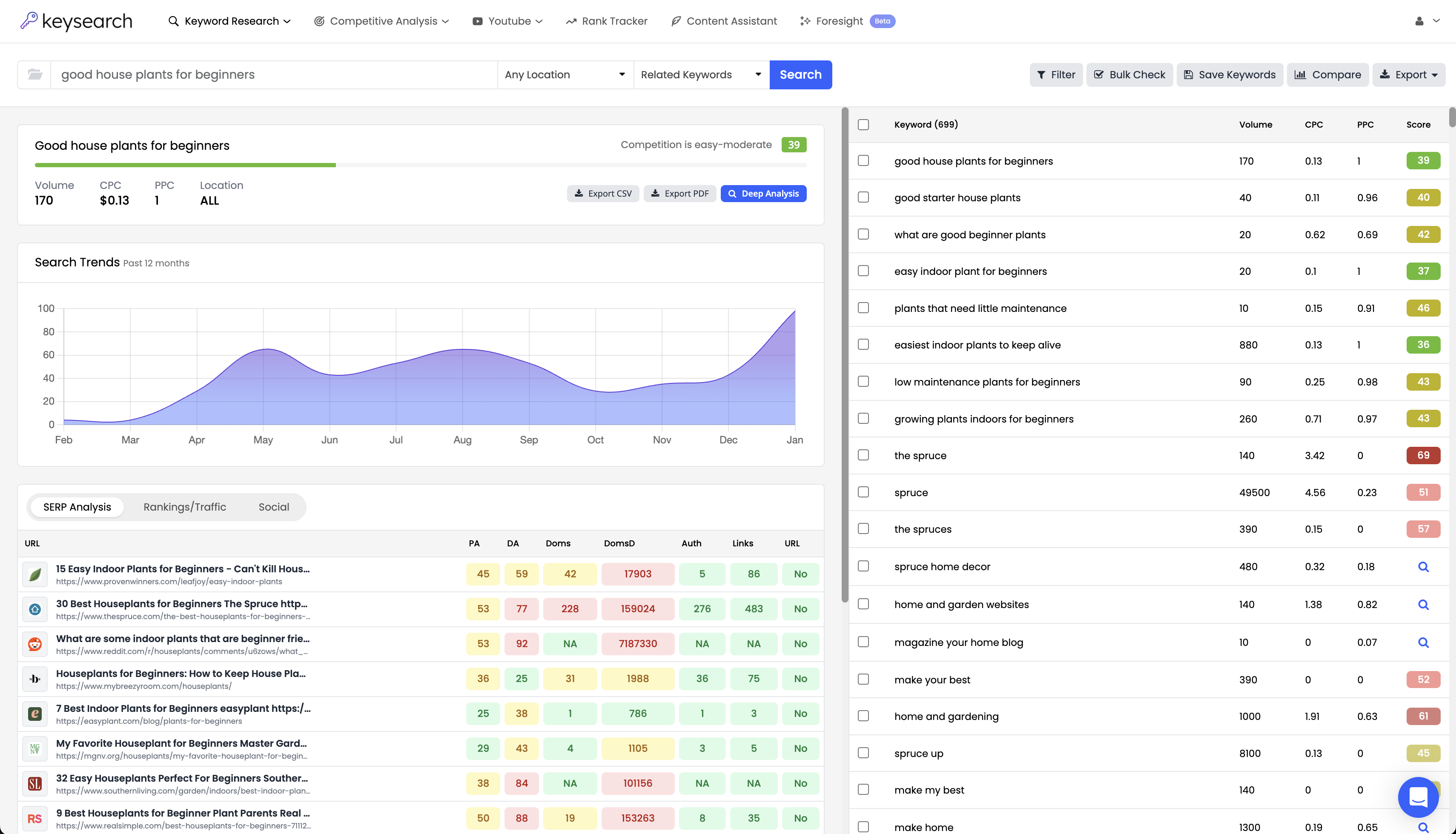So much emphasis is placed on high search volume, which is understandable. Those just starting out with SEO are focused on getting the best return on their investment, and the concept of bringing in hundreds of thousands of searchers is more compelling than just a few hundred.
But, the more you learn about SEO, the more you’ll realize there is give and take. These high search volume opportunities are inherently more difficult. Sometimes, they’re not quite as relevant as you’d like either.
That’s why you need to know about the long tail keywords benefits. No matter your goals, focusing your attention on long-tail keywords will deliver a better bang for your buck. They have lower difficulty and higher relevancy which leads to higher conversion rates.
Learn more about the SEO benefits of long tail keywords below, including how our long tail keyword generator here at Keysearch can help you uncover these opportunities on autopilot. Start executing the most effective SEO strategy possible today!
What are Long Tail Keywords?
Long tail keywords are longer, more specific phrases users enter into search engines when trying to find something – be it information or a product/service.
Broad keywords are typically one or two words and are highly competitive with higher search volume. On the other hand, long tail keywords often consist of three or more words. they’re usually more descriptive and target niche audiences with particular needs or interests.
For example, instead of targeting the keyword “running shoes,” a long tail keyword might be “women’s running shoes for flat feet.” Or, maybe it’s “barefoot running shoes wide toe box.”
While the search volume for such a specific phrase is likely lower, the audience searching for it is much more likely to be looking to make a purchase or take a specific action. You’ll have a far easier time ranking for it, too.
What are the SEO Benefits of Long Tail Keywords?
You’re probably already starting to see the benefits of using long tail keywords – but let’s take a closer look to show you just how powerful these can be as part of your SEO strategy. Here are the long tail keywords benefits you need to know about.
Lower Competition
The most notable benefit of long tail keywords is they are typically less difficult to rank for. If you’re just running a PPC campaign and not worried about rankings, this lower competition translates into lower advertising costs.
Broad, popular keywords are often dominated by large, established websites with ample resources dedicated to ranking for those terms. Competing for these high-traffic keywords can be challenging for smaller or newer sites.
You have a greater chance of ranking higher in SERPs by focusing on more niche terms. This drives more organic traffic to your site since you’ll be reaching users who are searching for something highly specific – exactly what you offer.
Now, what is a good keyword difficulty score to aim for? It all depends on your specific site’s authority and the value of the keyword in question. We have a keyword difficulty checker that can help you navigate this. Let’s look at some of the other long tail keywords benefits below.
Improved Content Relevance
Even if you can rank for something with higher search volume and difficulty, doesn’t mean it’s a good use of resources. The keyword has to be relevant to your website.
Long tail keywords allow you to be way more precise in the type of content you create for your users. The specificity of the long tail variation means you can hone in on the exact questions, concerns, or interests a user has. In other words, you’re able to build more trust as you resonate with them.
Improved content relevance doesn’t just benefit your audience, though. It also signals to search engines that your site is a valuable resource.
Search engines favor content that directly addresses user queries. Thus, you increase your chances of being recognized as a relevant and authoritative source in your niche by optimizing your content with long tail keywords.
Higher Conversion Rates
Given the specificity of these keywords, you’ll have a much easier time turning visitors into customers. The users searching long tail keywords have typically moved past the research phase and are now looking for specific products, services, or information that meets their needs. You attract a more qualified audience that is ready to take action by focusing on these keywords, whether that’s making a purchase, signing up for a newsletter, or filling out a contact form.
After all, the goal of SEO isn’t just to generate traffic – it’s conversions. Targeting long-tail variations is how you generate a tangible ROI from your efforts. This is important for your own website or for the websites of your clients if you’re an SEO agency.
Building Topical Authority
Topical authority is an important concept for ranking a website in today’s highly competitive search engine landscape. It’s basically a measure of how well your site covers a specific subject.
Creating content that thoroughly addresses a variety of long tail keywords within a particular niche positions your site as an expert resource on that topic. This signals to search engines that your site is an authoritative source.
As you consistently produce high-quality content around these keywords over time, you can strengthen your site’s overall authority. This can lead to better rankings not just for long tail keywords, but for more competitive, broad keywords as well. Speaking of which…
Ranking for More Difficult Keywords
One of the final SEO benefits of long tail keywords is how they empower you to eventually start ranking for more difficult keywords.
Think about it like this – long tail keywords often include your primary keyword within it. For example, if your goal is to one day rank for “running shoes”, ranking for “women’s running shoes for flat feet,” is a great starting point.
While any site can benefit from focusing resources on long tail keywords, it’s especially powerful for new sites just starting out. It sets a great foundation that allows you to build up relevancy and authority over time.
Are There Any Disadvantages of Long Tail Keywords?
It’s clear there are benefits of using long tail keywords, but what’s the downside – if any? In case it wasn’t obvious, you’re going to end up sacrificing search volume, but that’s really it.
Because these keywords are more specific and niche, fewer people are searching for them compared to broader, more general keywords. While you may rank well for a long tail keyword, the traffic driven to your site might be lower than if you were targeting more popular terms.
The strategy of ranking for all the long-tail variations in your niche can also be time-consuming from a content creation perspective. Broad keywords can be covered by a single article or page, whereas long tail keywords may need multiple pieces of content to fully cover the topic.
However, we believe strongly that the long tail keywords benefits greatly outweigh the decreased search volume and increased effort. Plus, you can learn how to automate keyword research to streamline things and make the process more efficient.
The first step? Finding getting set up with our free SEO tools at Keysearch!
Start Reaping the Long Tail Keywords Benefits With Keysearch Today!
Keysearch has earned the trust of more than 10,000 individuals for our effective, affordable SEO toolkit. You get access to everything you need to map out and execute an SEO strategy, whether you’re looking for Etsy long-tail keywords or trying to create a niche blog site.
What Makes Our Long Tail Keyword Generator the #1 Choice?
While there are so many different tools you can use to help reap the SEO benefits of long tail keywords, ours offers unparalleled accuracy. It pulls data not just from Google but other search engines based on the platform you’re trying to rank on.
You won’t get overwhelmed with unnecessary features, either. Simply input your seed keyword and you’ll be net with a list of keywords that have 3 or more words. Or, you can configure the parameters to show you keywords that have 4 or more words.
As per our keyword research checklist, you can also filter the difficulty to show you the https://www.keysearch.co/top-keywords/keyword-lists”>top keywords you actually have a chance of ranking for.
Then, it’s just a matter of filtering keywords for relevancy and aligning your selection with your goals. For example, if you’re targeting keywords with strong buying intent, focus on phrases that include terms like “buy,” “best,” or “reviews.”
When it comes to figuring out how to find niche keywords, there is no better way than our long-tail keyword generator. Start using it today and see for yourself how easy it can be! In the meantime, we want to quickly touch on what to do after keyword research.
Optimizing Content Accordingly
Creating content with long-tail keywords is not any different from optimizing content with broader keywords. They should be integrated into the title, meta description, and URL slug of products and blog posts alike.
Use the keywords sparingly in your headings and body text as well, focusing on a keyword density of no more than 0.5% to 1%. Less is more, as you want to avoid keyword stuffing. You can fill in the gaps by including secondary keywords throughout the content.
If you have images on the page, don’t forget to fill in the alt text with your primary and secondary keywords as well. Set up rank tracking once you’ve put the new content live and behold as the traffic starts to flow in over time!
Bringing Our Long Tail Keywords Benefits Guide to a Close
That does it for our guide to the SEO benefits of long tail keywords. These are some of the best ways for newer or less authoritative sites to drive targeted traffic, improve content relevance, enhance topical authority, and boost conversion rates.
Now that you know not just the long tail keywords benefits, but how to uncover them and use them in your content, it’s time to get started with our intuitive long-tail keyword generator.
It’s just one of the many tools you have at your disposal here at Keysearch, too. This is truly your all-in-one SEO toolkit. Here are some other popular features you’ll get access to with your account:
- Niche finder
- Keyword density checker
- LSI keyword generator
- Robots.txt generator
- SERP simulator
- Duplicate content checker
- Keyword clustering tool
- YouTube keyword generator
- Pinterest keyword tool
- Amazon keyword tool
- Etsy keyword tool
Our blog has additional resources on how to do Pinterest keyword research, how to do Amazon keyword research, how to do Etsy keyword research, how to do keyword research for Youtube, how to check keyword density, does keyword density matter, and more.
Or, if you’re still not sure Keysearch is the right solution for your SEO research and execution, see how it stacks up to the competition. We’ve got a comparison of Keysearch vs Ahrefs, Keysearch vs Ubersuggest, Keysearch vs Semrush, and even Keysearch vs SE Ranking.
See firsthand how simple planning and executing an SEO strategy can be with Keysearch today. Take advantage of our tools to start seeing rapid results in your online presence!
- How to Do Keyword Research for Free: Best Free Keyword Research Tools in 2024 - December 13, 2024
- Benefits of Keyword Clustering: Why is it Important to Group Relevant Keywords Together? - December 13, 2024
- What is Keyword Density in SEO and Its Importance - December 13, 2024







